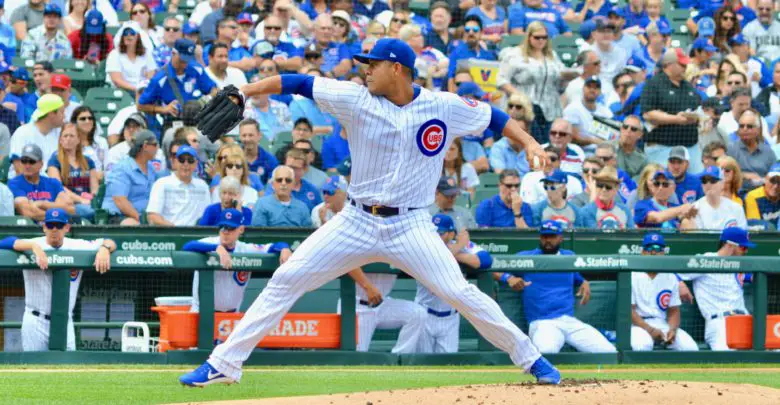
These 3 Turning Points Helped Close Cubs’ Window
In trading Yu Darvish for Zach Davies and a collection of prospects a couple of years away from their first legal IPA, the Cubs sent an unambiguous signal that their competitive window is coming to a close. Like William Henry Harrison, they reached the mountaintop only to find their stay there would be short.
That frugality on the part of ownership has contributed to this should go without saying. An unwillingness to spend new money to improve the club over the last several years has contributed significantly to the organization’s decline.
Despite the inescapability of that reality, there have been other missteps along the way. As Pat Hughes will often tell you, outcomes in baseball can hang on a small handful of turning points. Ron Coomer would agree. Three such moments in particular, one of which is really a series of events and decisions, have played an outsized role in pushing the Cubs toward the spot in which they now find themselves.
Playing it safe in pitching development
The pitfalls of the Cubs’ choices in terms of drafting and developing pitchers during the early days of Theo Epstein’s regime have been fairly well documented. In opting for low-ceiling, high-floor college pitching prospects, the Cubs hoped they’d be able to have competent pitchers coming up in regular waves to fill holes at the major league roster. That plan never really developed.
In sacrificing upside, the organization badly miscalculated the importance of velocity and pure stuff, and in doing so, failed to produce pitchers of any significant impact from the period in which they employed this “play it safe” philosophy.
While things have changed for the better of late, Rob Zastryzny remained the most impactful homegrown farmhand to reach Chicago for far too long. This inability to develop pitching talent forced the Cubs to pay through the nose in either money or elite prospects just to plug holes on the pitching staff. The trade for Justin Wilson in 2017, the signing of Steve Cishek that offseason, and that trade that we’re about to get into underscore just how impactful this organizational failure was.
José Quintana Trade
Sure, this is a bit of a continuation of the last section, but the team’s 2017 trade for former White Sox lefty José Quintana deserves special attention.
In trading Dylan Cease and especially Eloy Jiménez, the Cubs removed the last remaining high caliber talent from a farm system that was once an embarrassment of riches. While trading prospect capital for win-now big leaguers can be a normal part of a competitive cycle, as the Cubs did a year earlier in trading Gleyber Torres for Aroldis Chapman, the Quintana trade didn’t have the kind of impact that justified the hefty price.
That Jiménez has gone on to be every bit the hitter he was expected to be and that Cease seems capable of success at the big league level isn’t so important for the Cubs. What matters more is that Quintana just wasn’t as good as they’d hoped he’d be. After posting at least 4.0 fWAR for four straight seasons with the White Sox and a half season with the Cubs, Q failed to do so even once in a Cubs uniform over a full season.
While he’s been far from bad, the Cubs parted with a relatively elite package only to acquire someone who was merely fine.
Sticking with Addison Russell
Though the first to items listed above did plenty to close the Cubs’ window, no single factor contributed more to their downfall than Addison Russell’s failure to develop as a player or as a person. Team leaders’ embarrassing reluctance to distance themselves from him are a cherry on top of a rancid sundae.
Expected to be more or less in line with Kris Bryant as a perennial MVP candidate — and even introduced by Len Kasper as a “future MVP” during the team’s ring ceremony — Russell never lived up to the expectations set for him. Even his strong 2016 season, which was bolstered by an especially strong first half, saw him produce at a below-average rate offensively. A combination of injuries, inability to learn signs, and struggles at the plate dashed any hopes of Russell becoming a more productive player.
That he failed to become an adequate major league hitter is perhaps a negative reflection on the Cubs’ development philosophy on the hitting side. Far more damning was the team’s insistence on sticking by him through truly grotesque accusations of spousal abuse and domestic violence. One could reasonably suspect that despite the heinous accusations against Russell, the team viewed his development into at least a competent player as a key ingredient to the team reaching its greatest heights again.
That he didn’t certainly contributed to the fact that the Cubs didn’t.
Taken in a vacuum, Russell’s failure to develop on its own may not have sunk the Cubs. None of the issues discussed above did. That the window is closing fast is a byproduct of one too many crossroads where the team chose the wrong direction. I guess you could say they forked up. And now it seems they’re going to try to find their way back with a whole new map and a new navigator charting the course.
Let’s just hope they’ve truly learned from their mistakes.

